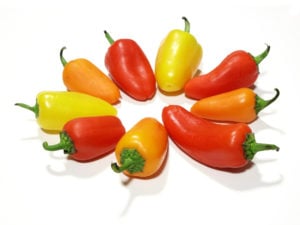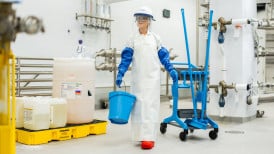Learning Center

The COVID-19 pandemic disrupted normal operations for countless food and beverage manufacturers. Disruptions from future pandemics may occur due to limited staff because of layoffs, social distancing requirements, or sickness; additional sanitation requirements to control viral transmission; changes in production levels; and possibly plant shutdown. These situations can lead to the need of resources for food safety sanitation.
It is essential that food manufacturers create safe, quality food, therefore, routine practices need to continue and additional sanitation may need to be added. Employers also need to ensure a safe environment for their staff, including minimizing the risk of being exposed to harmful viruses and infections.
While whipping up a quick dinner recently, I decided to use my handy-dandy microwave to get the rice cooking portion of the meal done. Just below, the thrilling smells of cooking vegetables and fish wafted up as I did my best not to burn what was in the pan in front of me on the stove. Feeling good about my culinary self momentarily, I casually glanced up at the microwave. Torrents of foam cascaded out of the vessel I had put the rice in...in the end, I had cooked rice and a significant starchy mess to clean up. When on top of a freshly poured beer, a healthy level of foam can bring me great joy; in this instance, it brought me back to Earth in terms of thinking about my talents in the kitchen.
Now, take that unfortunate incident and think about a food processing facility producing your favorite products. Foam happens in many food
Selecting the right safety sign is a critical task in maintaining a secure work environment, and several key factors must be considered in this process. OSHA and ANSI regulations mandate that signage effectively communicates and defines specific hazards that pose a risk of injury or even death if left unidentified. One crucial aspect to contemplate is the safety sign header, which specifies the degree of hazard applicable to your situation. Different headers cater to distinct hazard levels, ensuring a clear and accurate indication of potential dangers. Explore the nuances of Danger, Warning, Caution, Notice, and Safety First signs, each serving a unique purpose in conveying the severity of potential hazards. Whether it's an immediate danger with a high probability of severe consequences or a cautionary note about a potentially hazardous situation, understanding the distinctions in safety signage headers is essential for creating a safe and informed workplace.
Saint Augustine is attributed as stating: “We make a ladder for ourselves of our vices, if we trample those same vices underfoot.” Inspiring words...and tangentially,


Selecting the appropriate material for safety signs is a crucial decision, influenced by various factors such as the time of day, temperature, and intended usage. The choice of material significantly impacts the sign's visibility, durability, and overall effectiveness. To assist in making informed decisions, the table below serves as a valuable guide, providing insights into the characteristics and suitability of different materials for specific applications. Whether it's ensuring visibility in low-light conditions, withstanding extreme temperatures, or meeting the demands of particular environments, this guide aids in the thoughtful selection of materials to enhance the overall efficacy of safety signage in diverse settings.
Custom shadow boards offer numerous advantages, contributing to the efficient organization of tools and the enhancement of workplace safety. Aligned with the principles of the 5S methodology—Sort, Set to Order, Shine, Standardize, and Sustain—custom shadow boards play a crucial role in fulfilling these requirements. The choice of material is a pivotal decision, and there are three options available to cater to different purposes: General Purpose Composite, Industrial Grade Aluminum, and Pro Series Acrylic. Each material has distinct features and temperature ranges suitable for various environments. To create a custom shadow board, a step-by-step process is outlined. It begins with selecting the board material, followed by identifying the tools to be shadowed, choosing the title and background color, specifying the board size, and considering additional information like color-coding charts, company name, logo, or images. By following these steps, businesses can tailor their shadow
Do you like things spicy? Are you prone to throw a bit (or a lot) of pepperjack on your sandwich to remind you you’re alive? Maybe the mild burn isn’t enough for you...maybe you want to take your taste buds to the edge, shaking the very fabric of common sense, by combining ghost pepper cheese and that cracker? For those looking to add a bit of “pep” with your pepper, to those aiming to melt their very consciousnesses, Nelson-Jameson is a progressive enabler of the peppery American palate.
Working together with another family-owned  company, EDCO Food Products, Nelson-Jameson hauls approximately 20 truckloads of peppers up to Wisconsin every month. Those peppers are distributed to food processors
company, EDCO Food Products, Nelson-Jameson hauls approximately 20 truckloads of peppers up to Wisconsin every month. Those peppers are distributed to food processors
Now, it wouldn't be too unusual to dedicate an entire article to salami and Swiss cheese because of the industry that we work in, but this charcuterie talk may not be what you’re expecting. I’ll pose this question first; have you ever had so many tasks to do and decisions to make at one time that you froze right in your tracks? Or felt so completely overwhelmed that you didn’t know where to start? If you have, you are definitely not alone. Research shows this is a normal response that occurs in your brain under these circumstances. Fortunately, there are some positive ways to approach these situations and help get you back on your productivity track. The ones that I’ve found to work well are the Swiss cheese and salami slice methods.
Taking small ‘bites” or poking “holes” in a large task or project would be considered the “Swiss cheese” method. This proven productivity method
Nelson-Jameson has our own line of high-quality, low-cost branded pH buffers. Reference buffers are available in pH 4.01, 5.00, 7.00, and 10.01, and are manufactured for utmost accuracy and repeatability.
They are color-coded for ease of use when training new laboratory, operational staff, or a tenured laboratory technician. Feel confident that they will be free of contamination and tampering with a pressure-sensitive seal that bonds to the bottle as well as a safety seal and torque-testing to ensure the cap is secure.
A pH/temperature table is printed on the bottle label for accurate calibration. The buffers are NIST traceable, and are manufactured under ISO 9000 quality standards. They are available in different size packaging options such as 475 mL and 1 gallon to accommodate any size operation.
If you are looking for cost savings and a quality line of pH buffers suitable for any laboratory, contact a Product Specialist today for more information!
Understanding the diverse landscape of stainless steel grades is imperative, especially when catering to the specific requirements of food-related industries. With approximately 150 stainless steel grades available today, only a select few meet the rigorous standards for food-grade applications. The 300 and 400 series steel dominate the food-grade stainless steel landscape. The 300-series, distinguished by the presence of chromium and nickel, includes notable variations like 304, widely employed in dairy, beer, and food processing due to its exceptional corrosion resistance. The 400-series, characterized by chromium dominance, encompasses varieties such as 430, notable for its susceptibility to corrosion in challenging environments. To qualify as food-grade stainless steel, the material must withstand acids, alkalis, and chlorides, ensuring resistance to caustic substances that could contribute to premature corrosion. Explore the intrinsic properties, types, and applications of food-grade






